Developing Strategies for Performance Management at Unilever: A Report
VerifiedAdded on 2023/05/31
|29
|6357
|213
Report
AI Summary
This report provides a comprehensive analysis of workplace relationships and employee development strategies within Unilever, a multinational corporation. The study begins with an executive summary highlighting the importance of employee-management relationships, particularly in complex organizations. The report delves into Unilever's financial performance, HR metrics, and employee training programs, revealing insights into the company's approach to performance management and employee development. The report examines the potential benefits of employee development, including alignment with macroeconomic changes, political factors, and retaining a competitive position in the global market. It evaluates Unilever's development vehicles and proposes strategies for managing individual expectations, including training and diversity management. Furthermore, it offers recommendations for improving employee development, focusing on training lower-level employees and empowering weaker subsidiaries to foster a more inclusive and effective work environment. The report utilizes Unilever's 'Developing & engaging our people' initiative as a case study to demonstrate the importance of strategies for performance management and employee development in workplaces. The report concludes with a call to action, urging Unilever to prioritize employee development to enhance its competitive advantage and overall organizational success.
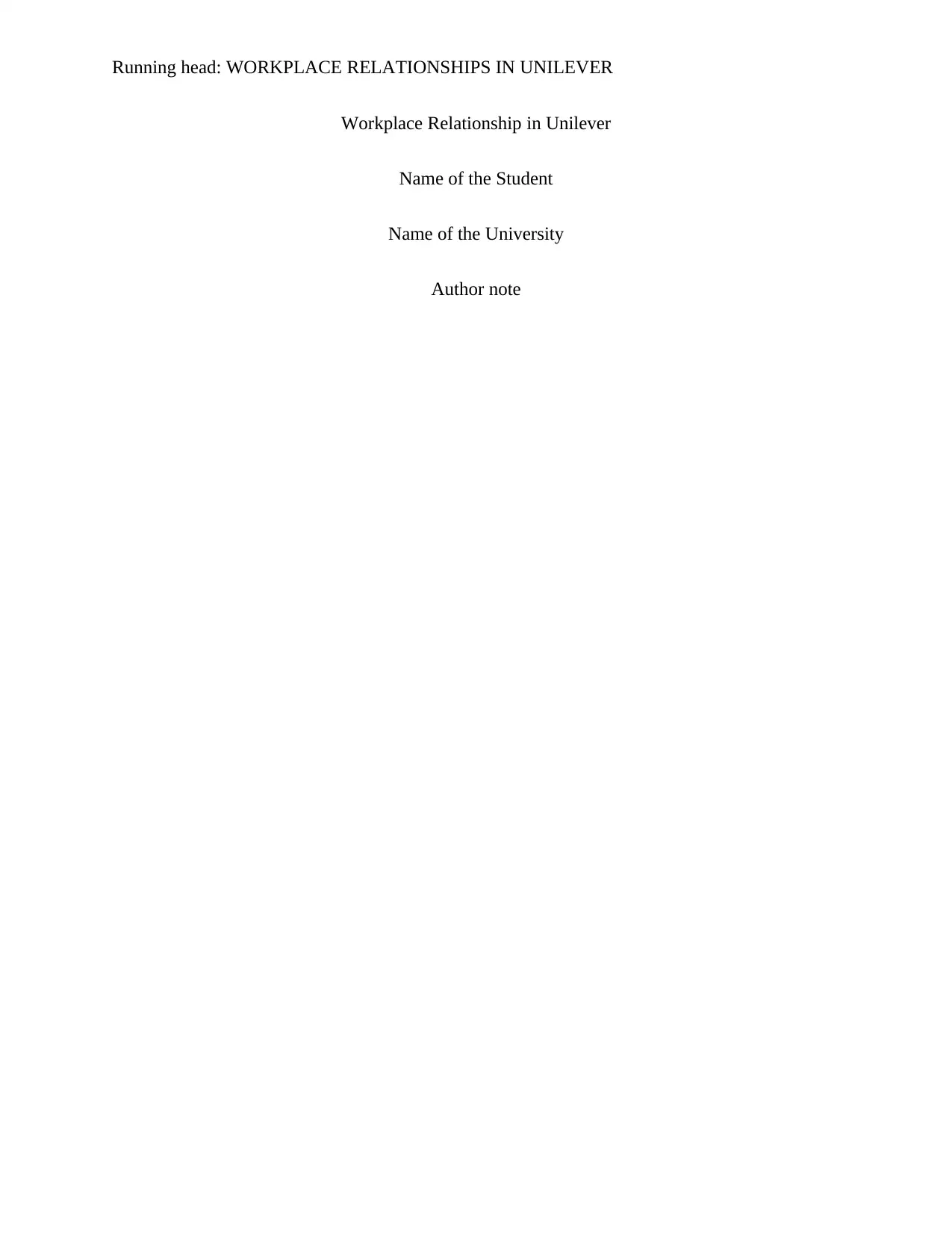
Running head: WORKPLACE RELATIONSHIPS IN UNILEVER
Workplace Relationship in Unilever
Name of the Student
Name of the University
Author note
Workplace Relationship in Unilever
Name of the Student
Name of the University
Author note
Paraphrase This Document
Need a fresh take? Get an instant paraphrase of this document with our AI Paraphraser
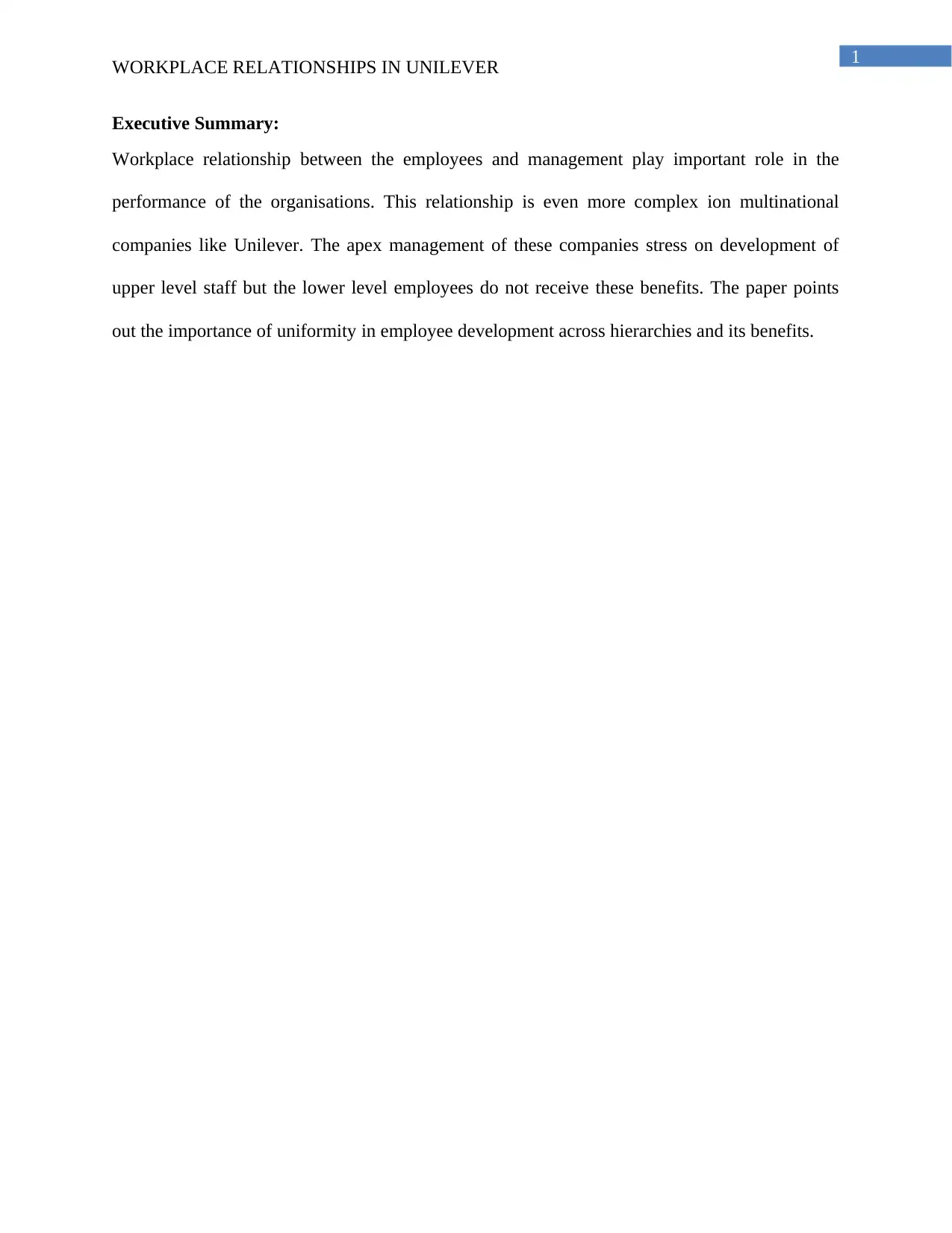
1
WORKPLACE RELATIONSHIPS IN UNILEVER
Executive Summary:
Workplace relationship between the employees and management play important role in the
performance of the organisations. This relationship is even more complex ion multinational
companies like Unilever. The apex management of these companies stress on development of
upper level staff but the lower level employees do not receive these benefits. The paper points
out the importance of uniformity in employee development across hierarchies and its benefits.
WORKPLACE RELATIONSHIPS IN UNILEVER
Executive Summary:
Workplace relationship between the employees and management play important role in the
performance of the organisations. This relationship is even more complex ion multinational
companies like Unilever. The apex management of these companies stress on development of
upper level staff but the lower level employees do not receive these benefits. The paper points
out the importance of uniformity in employee development across hierarchies and its benefits.
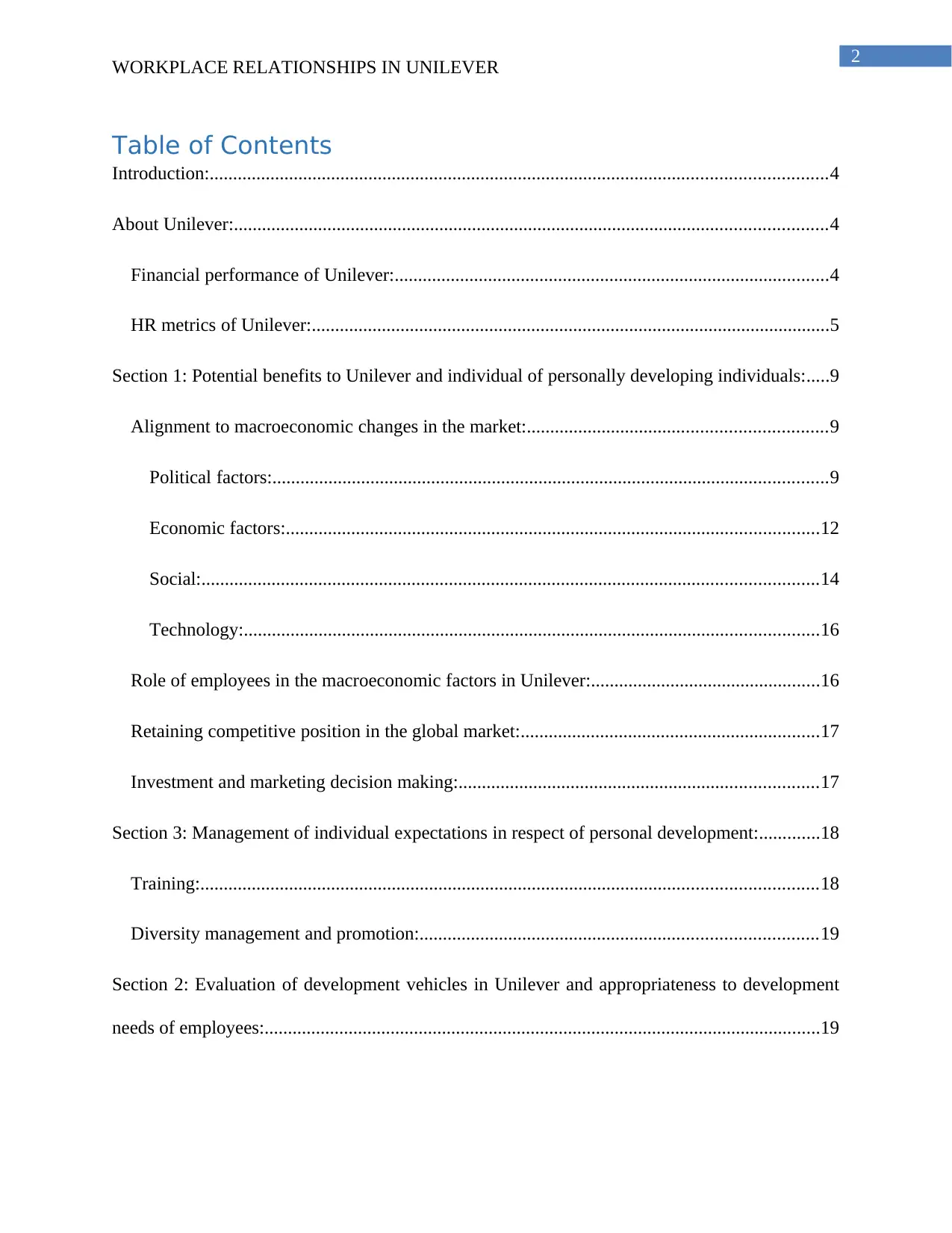
2
WORKPLACE RELATIONSHIPS IN UNILEVER
Table of Contents
Introduction:....................................................................................................................................4
About Unilever:...............................................................................................................................4
Financial performance of Unilever:.............................................................................................4
HR metrics of Unilever:...............................................................................................................5
Section 1: Potential benefits to Unilever and individual of personally developing individuals:.....9
Alignment to macroeconomic changes in the market:................................................................9
Political factors:.......................................................................................................................9
Economic factors:..................................................................................................................12
Social:....................................................................................................................................14
Technology:...........................................................................................................................16
Role of employees in the macroeconomic factors in Unilever:.................................................16
Retaining competitive position in the global market:................................................................17
Investment and marketing decision making:.............................................................................17
Section 3: Management of individual expectations in respect of personal development:.............18
Training:....................................................................................................................................18
Diversity management and promotion:.....................................................................................19
Section 2: Evaluation of development vehicles in Unilever and appropriateness to development
needs of employees:.......................................................................................................................19
WORKPLACE RELATIONSHIPS IN UNILEVER
Table of Contents
Introduction:....................................................................................................................................4
About Unilever:...............................................................................................................................4
Financial performance of Unilever:.............................................................................................4
HR metrics of Unilever:...............................................................................................................5
Section 1: Potential benefits to Unilever and individual of personally developing individuals:.....9
Alignment to macroeconomic changes in the market:................................................................9
Political factors:.......................................................................................................................9
Economic factors:..................................................................................................................12
Social:....................................................................................................................................14
Technology:...........................................................................................................................16
Role of employees in the macroeconomic factors in Unilever:.................................................16
Retaining competitive position in the global market:................................................................17
Investment and marketing decision making:.............................................................................17
Section 3: Management of individual expectations in respect of personal development:.............18
Training:....................................................................................................................................18
Diversity management and promotion:.....................................................................................19
Section 2: Evaluation of development vehicles in Unilever and appropriateness to development
needs of employees:.......................................................................................................................19
⊘ This is a preview!⊘
Do you want full access?
Subscribe today to unlock all pages.

Trusted by 1+ million students worldwide
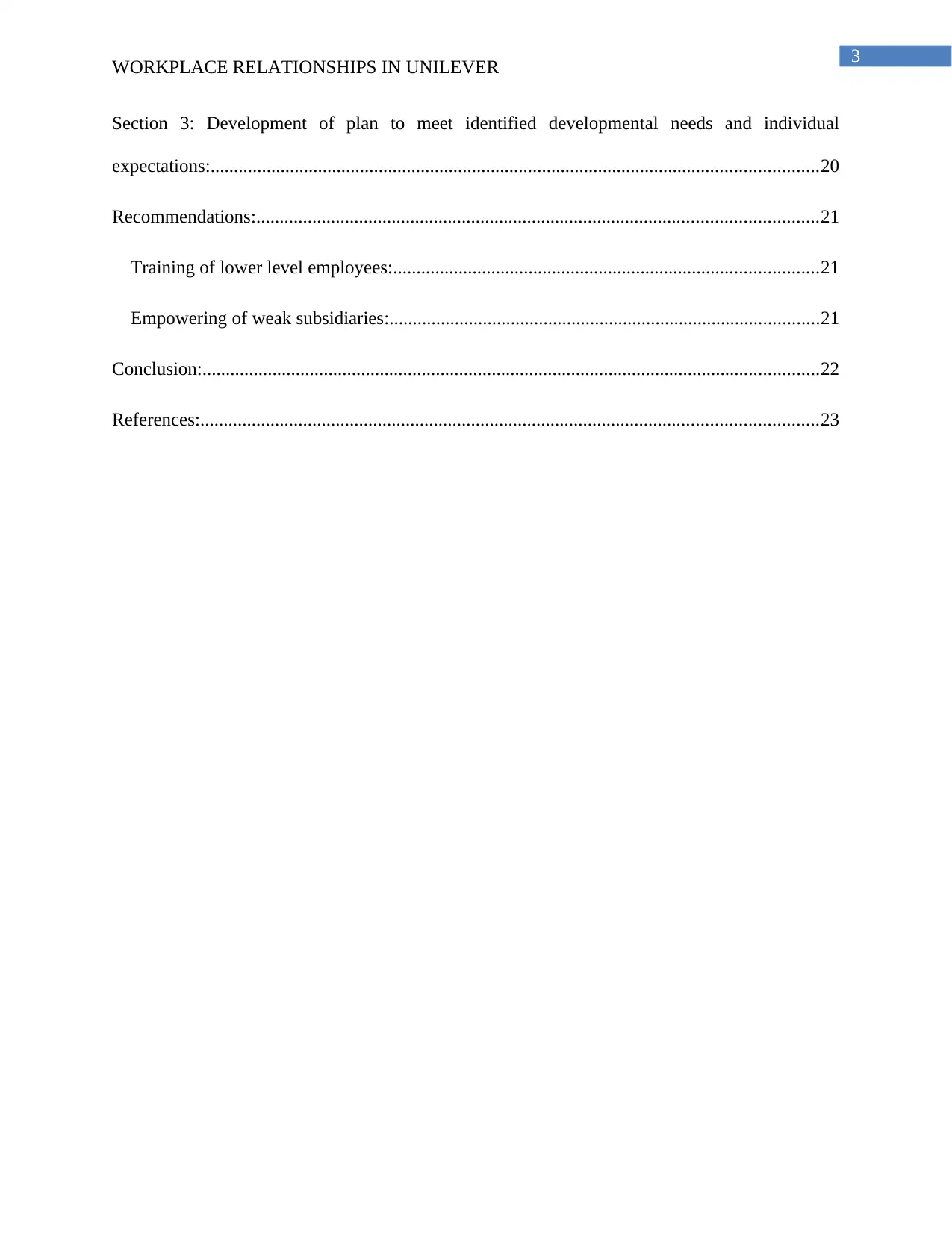
3
WORKPLACE RELATIONSHIPS IN UNILEVER
Section 3: Development of plan to meet identified developmental needs and individual
expectations:..................................................................................................................................20
Recommendations:........................................................................................................................21
Training of lower level employees:...........................................................................................21
Empowering of weak subsidiaries:............................................................................................21
Conclusion:....................................................................................................................................22
References:....................................................................................................................................23
WORKPLACE RELATIONSHIPS IN UNILEVER
Section 3: Development of plan to meet identified developmental needs and individual
expectations:..................................................................................................................................20
Recommendations:........................................................................................................................21
Training of lower level employees:...........................................................................................21
Empowering of weak subsidiaries:............................................................................................21
Conclusion:....................................................................................................................................22
References:....................................................................................................................................23
Paraphrase This Document
Need a fresh take? Get an instant paraphrase of this document with our AI Paraphraser
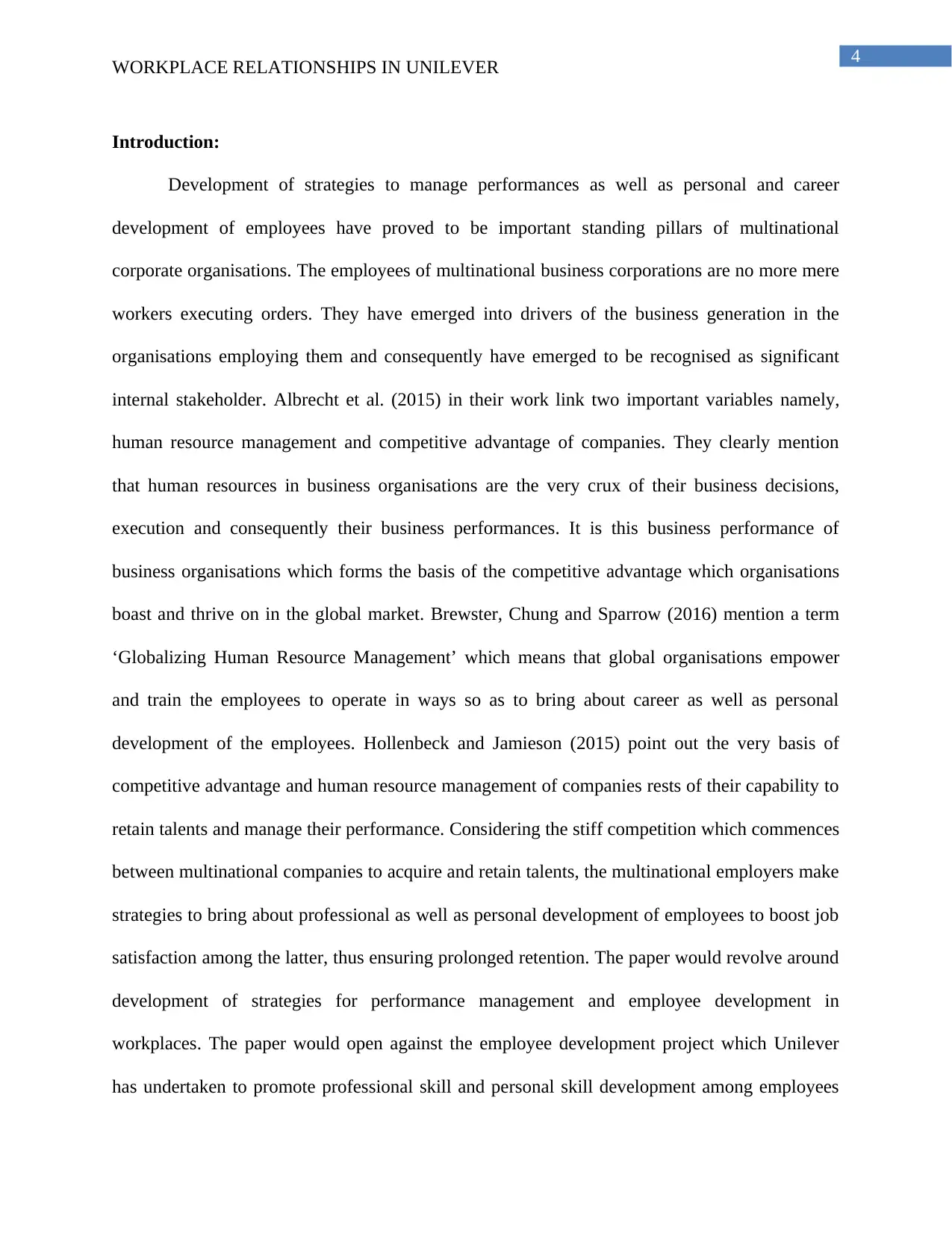
4
WORKPLACE RELATIONSHIPS IN UNILEVER
Introduction:
Development of strategies to manage performances as well as personal and career
development of employees have proved to be important standing pillars of multinational
corporate organisations. The employees of multinational business corporations are no more mere
workers executing orders. They have emerged into drivers of the business generation in the
organisations employing them and consequently have emerged to be recognised as significant
internal stakeholder. Albrecht et al. (2015) in their work link two important variables namely,
human resource management and competitive advantage of companies. They clearly mention
that human resources in business organisations are the very crux of their business decisions,
execution and consequently their business performances. It is this business performance of
business organisations which forms the basis of the competitive advantage which organisations
boast and thrive on in the global market. Brewster, Chung and Sparrow (2016) mention a term
‘Globalizing Human Resource Management’ which means that global organisations empower
and train the employees to operate in ways so as to bring about career as well as personal
development of the employees. Hollenbeck and Jamieson (2015) point out the very basis of
competitive advantage and human resource management of companies rests of their capability to
retain talents and manage their performance. Considering the stiff competition which commences
between multinational companies to acquire and retain talents, the multinational employers make
strategies to bring about professional as well as personal development of employees to boost job
satisfaction among the latter, thus ensuring prolonged retention. The paper would revolve around
development of strategies for performance management and employee development in
workplaces. The paper would open against the employee development project which Unilever
has undertaken to promote professional skill and personal skill development among employees
WORKPLACE RELATIONSHIPS IN UNILEVER
Introduction:
Development of strategies to manage performances as well as personal and career
development of employees have proved to be important standing pillars of multinational
corporate organisations. The employees of multinational business corporations are no more mere
workers executing orders. They have emerged into drivers of the business generation in the
organisations employing them and consequently have emerged to be recognised as significant
internal stakeholder. Albrecht et al. (2015) in their work link two important variables namely,
human resource management and competitive advantage of companies. They clearly mention
that human resources in business organisations are the very crux of their business decisions,
execution and consequently their business performances. It is this business performance of
business organisations which forms the basis of the competitive advantage which organisations
boast and thrive on in the global market. Brewster, Chung and Sparrow (2016) mention a term
‘Globalizing Human Resource Management’ which means that global organisations empower
and train the employees to operate in ways so as to bring about career as well as personal
development of the employees. Hollenbeck and Jamieson (2015) point out the very basis of
competitive advantage and human resource management of companies rests of their capability to
retain talents and manage their performance. Considering the stiff competition which commences
between multinational companies to acquire and retain talents, the multinational employers make
strategies to bring about professional as well as personal development of employees to boost job
satisfaction among the latter, thus ensuring prolonged retention. The paper would revolve around
development of strategies for performance management and employee development in
workplaces. The paper would open against the employee development project which Unilever
has undertaken to promote professional skill and personal skill development among employees
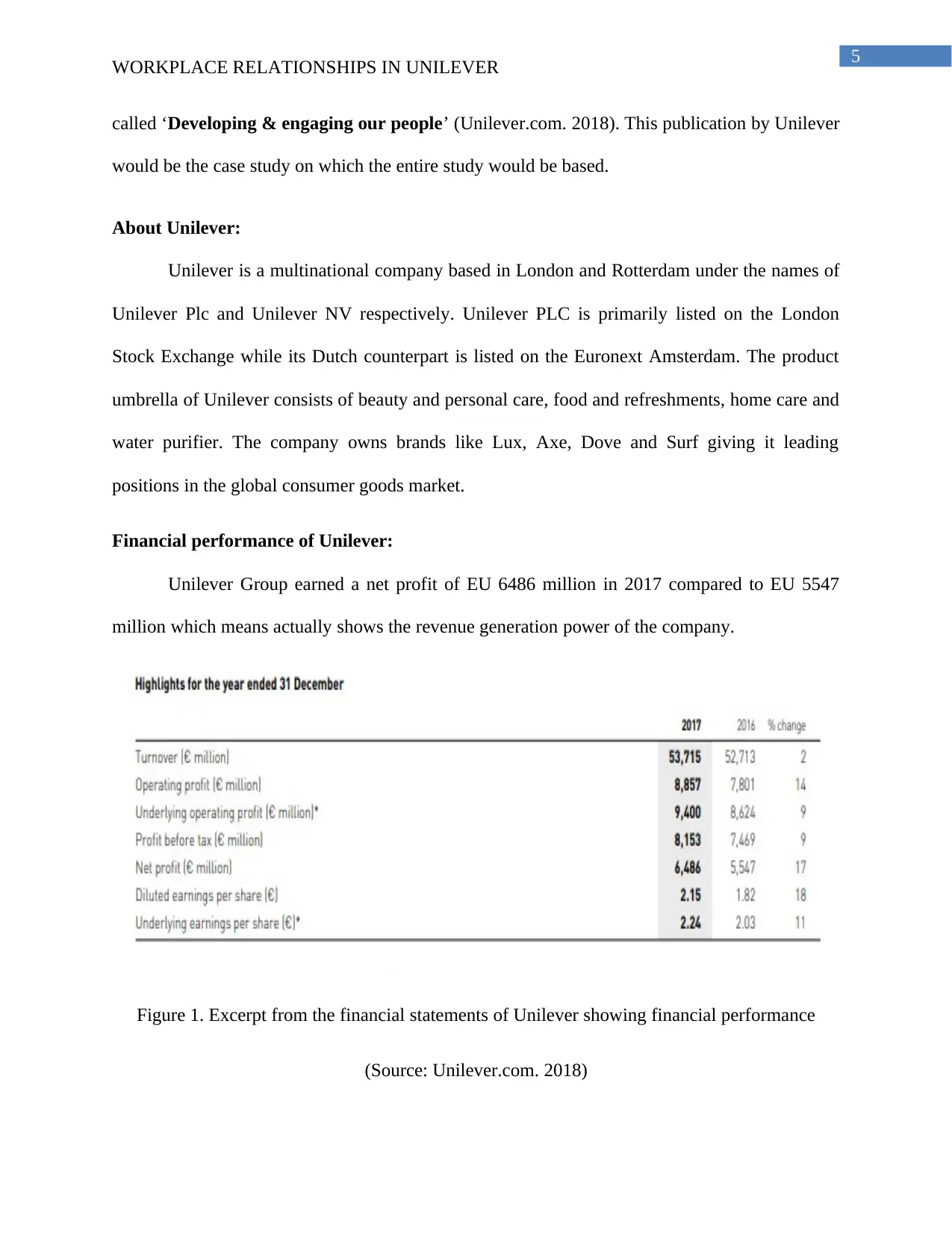
5
WORKPLACE RELATIONSHIPS IN UNILEVER
called ‘Developing & engaging our people’ (Unilever.com. 2018). This publication by Unilever
would be the case study on which the entire study would be based.
About Unilever:
Unilever is a multinational company based in London and Rotterdam under the names of
Unilever Plc and Unilever NV respectively. Unilever PLC is primarily listed on the London
Stock Exchange while its Dutch counterpart is listed on the Euronext Amsterdam. The product
umbrella of Unilever consists of beauty and personal care, food and refreshments, home care and
water purifier. The company owns brands like Lux, Axe, Dove and Surf giving it leading
positions in the global consumer goods market.
Financial performance of Unilever:
Unilever Group earned a net profit of EU 6486 million in 2017 compared to EU 5547
million which means actually shows the revenue generation power of the company.
Figure 1. Excerpt from the financial statements of Unilever showing financial performance
(Source: Unilever.com. 2018)
WORKPLACE RELATIONSHIPS IN UNILEVER
called ‘Developing & engaging our people’ (Unilever.com. 2018). This publication by Unilever
would be the case study on which the entire study would be based.
About Unilever:
Unilever is a multinational company based in London and Rotterdam under the names of
Unilever Plc and Unilever NV respectively. Unilever PLC is primarily listed on the London
Stock Exchange while its Dutch counterpart is listed on the Euronext Amsterdam. The product
umbrella of Unilever consists of beauty and personal care, food and refreshments, home care and
water purifier. The company owns brands like Lux, Axe, Dove and Surf giving it leading
positions in the global consumer goods market.
Financial performance of Unilever:
Unilever Group earned a net profit of EU 6486 million in 2017 compared to EU 5547
million which means actually shows the revenue generation power of the company.
Figure 1. Excerpt from the financial statements of Unilever showing financial performance
(Source: Unilever.com. 2018)
⊘ This is a preview!⊘
Do you want full access?
Subscribe today to unlock all pages.

Trusted by 1+ million students worldwide
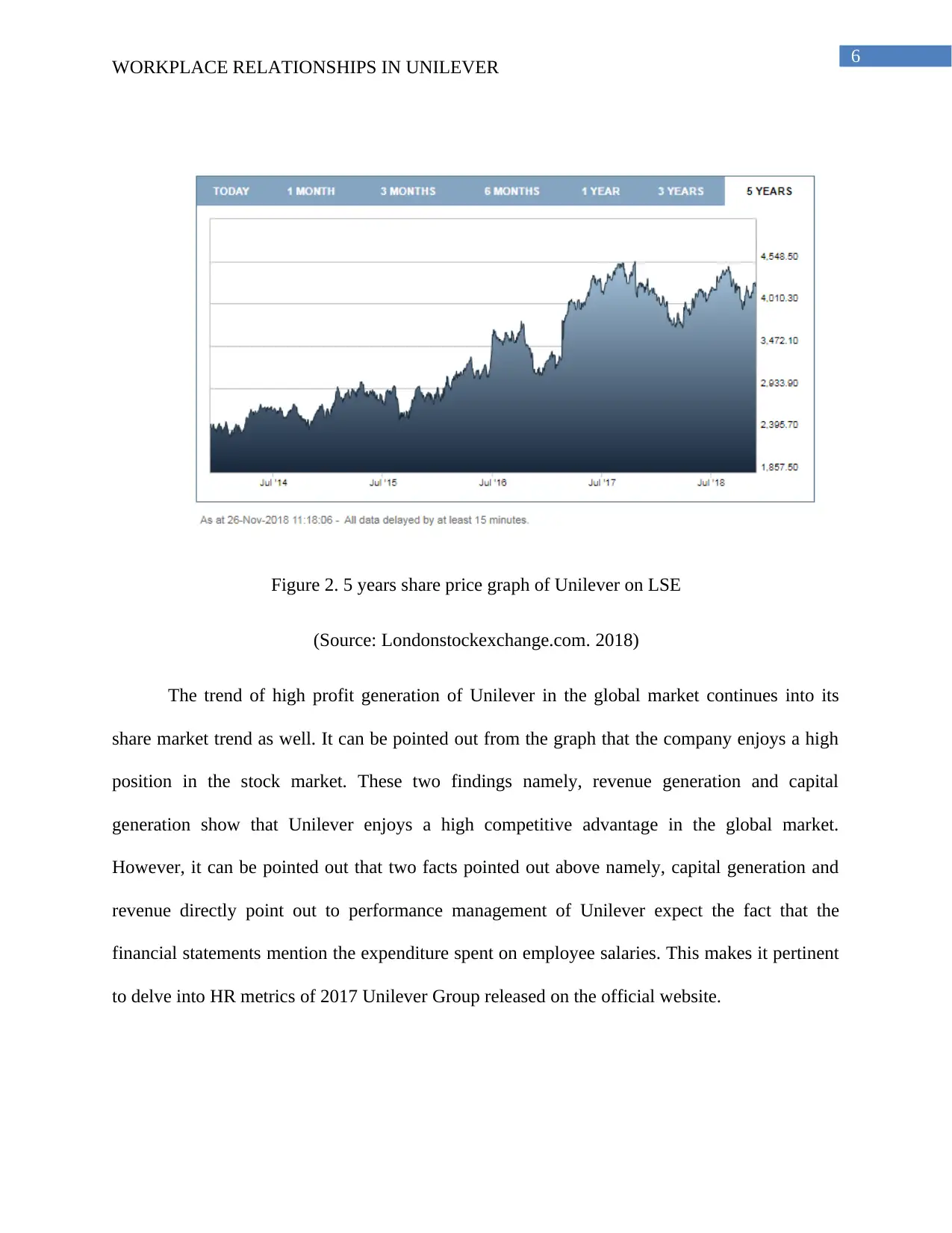
6
WORKPLACE RELATIONSHIPS IN UNILEVER
Figure 2. 5 years share price graph of Unilever on LSE
(Source: Londonstockexchange.com. 2018)
The trend of high profit generation of Unilever in the global market continues into its
share market trend as well. It can be pointed out from the graph that the company enjoys a high
position in the stock market. These two findings namely, revenue generation and capital
generation show that Unilever enjoys a high competitive advantage in the global market.
However, it can be pointed out that two facts pointed out above namely, capital generation and
revenue directly point out to performance management of Unilever expect the fact that the
financial statements mention the expenditure spent on employee salaries. This makes it pertinent
to delve into HR metrics of 2017 Unilever Group released on the official website.
WORKPLACE RELATIONSHIPS IN UNILEVER
Figure 2. 5 years share price graph of Unilever on LSE
(Source: Londonstockexchange.com. 2018)
The trend of high profit generation of Unilever in the global market continues into its
share market trend as well. It can be pointed out from the graph that the company enjoys a high
position in the stock market. These two findings namely, revenue generation and capital
generation show that Unilever enjoys a high competitive advantage in the global market.
However, it can be pointed out that two facts pointed out above namely, capital generation and
revenue directly point out to performance management of Unilever expect the fact that the
financial statements mention the expenditure spent on employee salaries. This makes it pertinent
to delve into HR metrics of 2017 Unilever Group released on the official website.
Paraphrase This Document
Need a fresh take? Get an instant paraphrase of this document with our AI Paraphraser
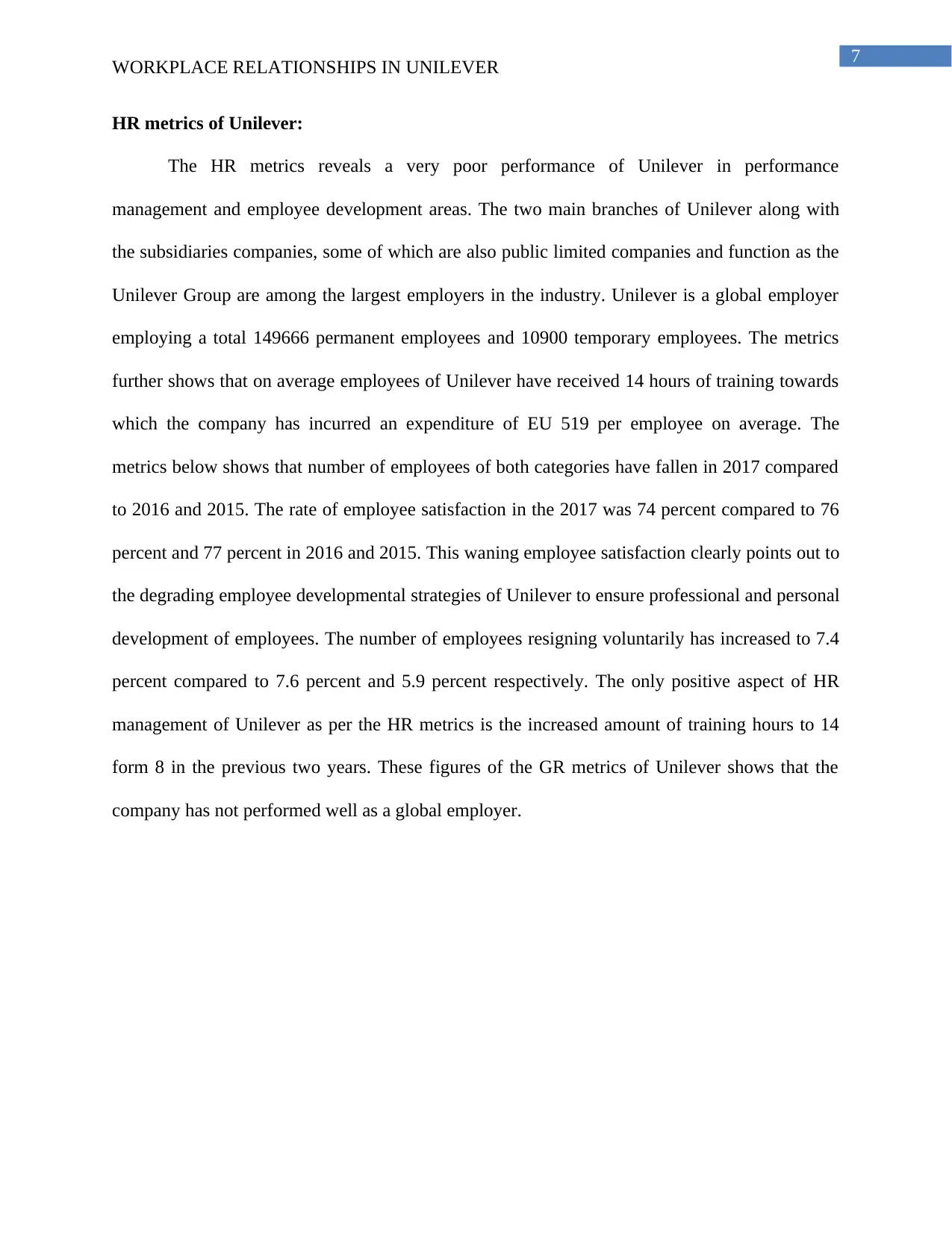
7
WORKPLACE RELATIONSHIPS IN UNILEVER
HR metrics of Unilever:
The HR metrics reveals a very poor performance of Unilever in performance
management and employee development areas. The two main branches of Unilever along with
the subsidiaries companies, some of which are also public limited companies and function as the
Unilever Group are among the largest employers in the industry. Unilever is a global employer
employing a total 149666 permanent employees and 10900 temporary employees. The metrics
further shows that on average employees of Unilever have received 14 hours of training towards
which the company has incurred an expenditure of EU 519 per employee on average. The
metrics below shows that number of employees of both categories have fallen in 2017 compared
to 2016 and 2015. The rate of employee satisfaction in the 2017 was 74 percent compared to 76
percent and 77 percent in 2016 and 2015. This waning employee satisfaction clearly points out to
the degrading employee developmental strategies of Unilever to ensure professional and personal
development of employees. The number of employees resigning voluntarily has increased to 7.4
percent compared to 7.6 percent and 5.9 percent respectively. The only positive aspect of HR
management of Unilever as per the HR metrics is the increased amount of training hours to 14
form 8 in the previous two years. These figures of the GR metrics of Unilever shows that the
company has not performed well as a global employer.
WORKPLACE RELATIONSHIPS IN UNILEVER
HR metrics of Unilever:
The HR metrics reveals a very poor performance of Unilever in performance
management and employee development areas. The two main branches of Unilever along with
the subsidiaries companies, some of which are also public limited companies and function as the
Unilever Group are among the largest employers in the industry. Unilever is a global employer
employing a total 149666 permanent employees and 10900 temporary employees. The metrics
further shows that on average employees of Unilever have received 14 hours of training towards
which the company has incurred an expenditure of EU 519 per employee on average. The
metrics below shows that number of employees of both categories have fallen in 2017 compared
to 2016 and 2015. The rate of employee satisfaction in the 2017 was 74 percent compared to 76
percent and 77 percent in 2016 and 2015. This waning employee satisfaction clearly points out to
the degrading employee developmental strategies of Unilever to ensure professional and personal
development of employees. The number of employees resigning voluntarily has increased to 7.4
percent compared to 7.6 percent and 5.9 percent respectively. The only positive aspect of HR
management of Unilever as per the HR metrics is the increased amount of training hours to 14
form 8 in the previous two years. These figures of the GR metrics of Unilever shows that the
company has not performed well as a global employer.
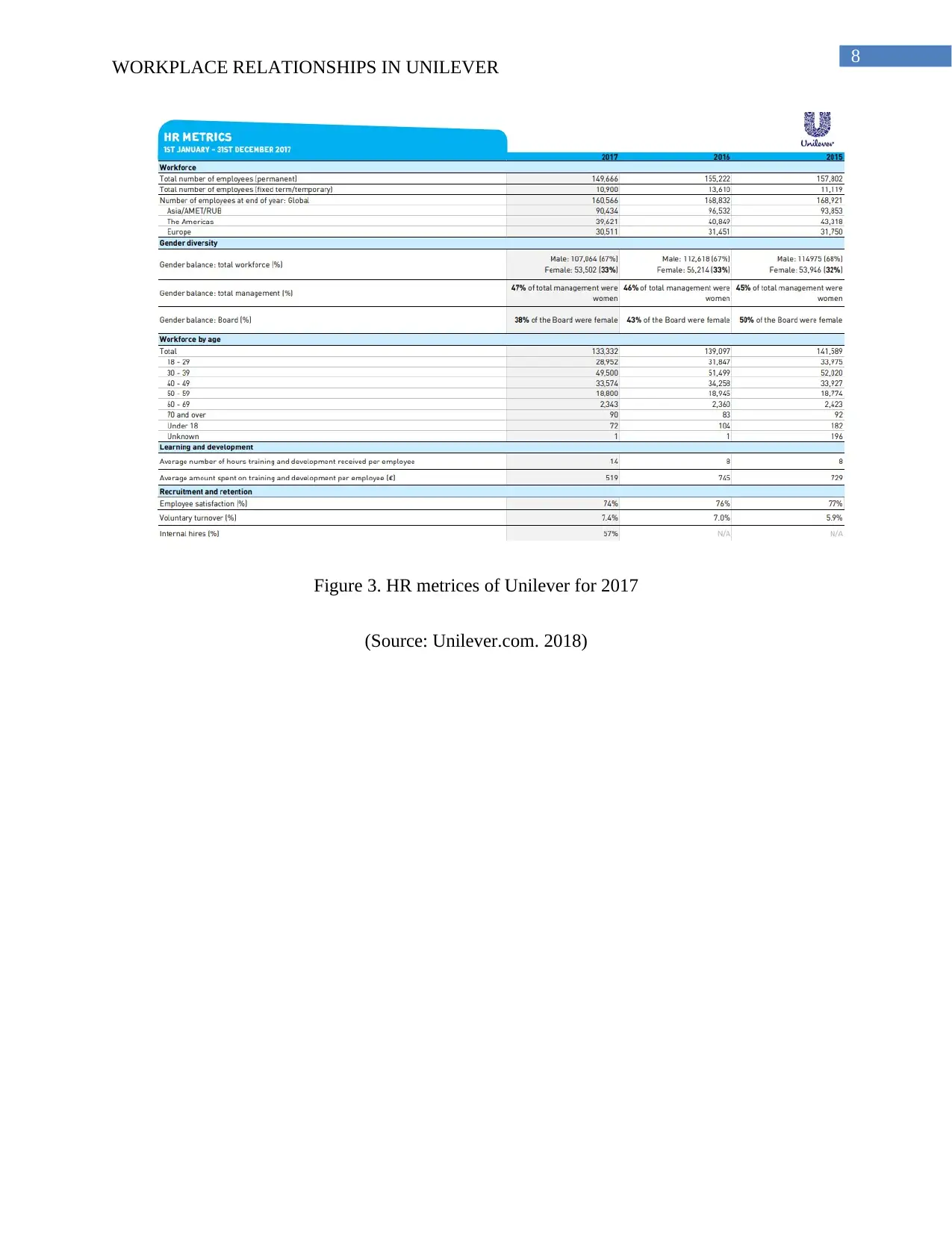
8
WORKPLACE RELATIONSHIPS IN UNILEVER
Figure 3. HR metrices of Unilever for 2017
(Source: Unilever.com. 2018)
WORKPLACE RELATIONSHIPS IN UNILEVER
Figure 3. HR metrices of Unilever for 2017
(Source: Unilever.com. 2018)
⊘ This is a preview!⊘
Do you want full access?
Subscribe today to unlock all pages.

Trusted by 1+ million students worldwide
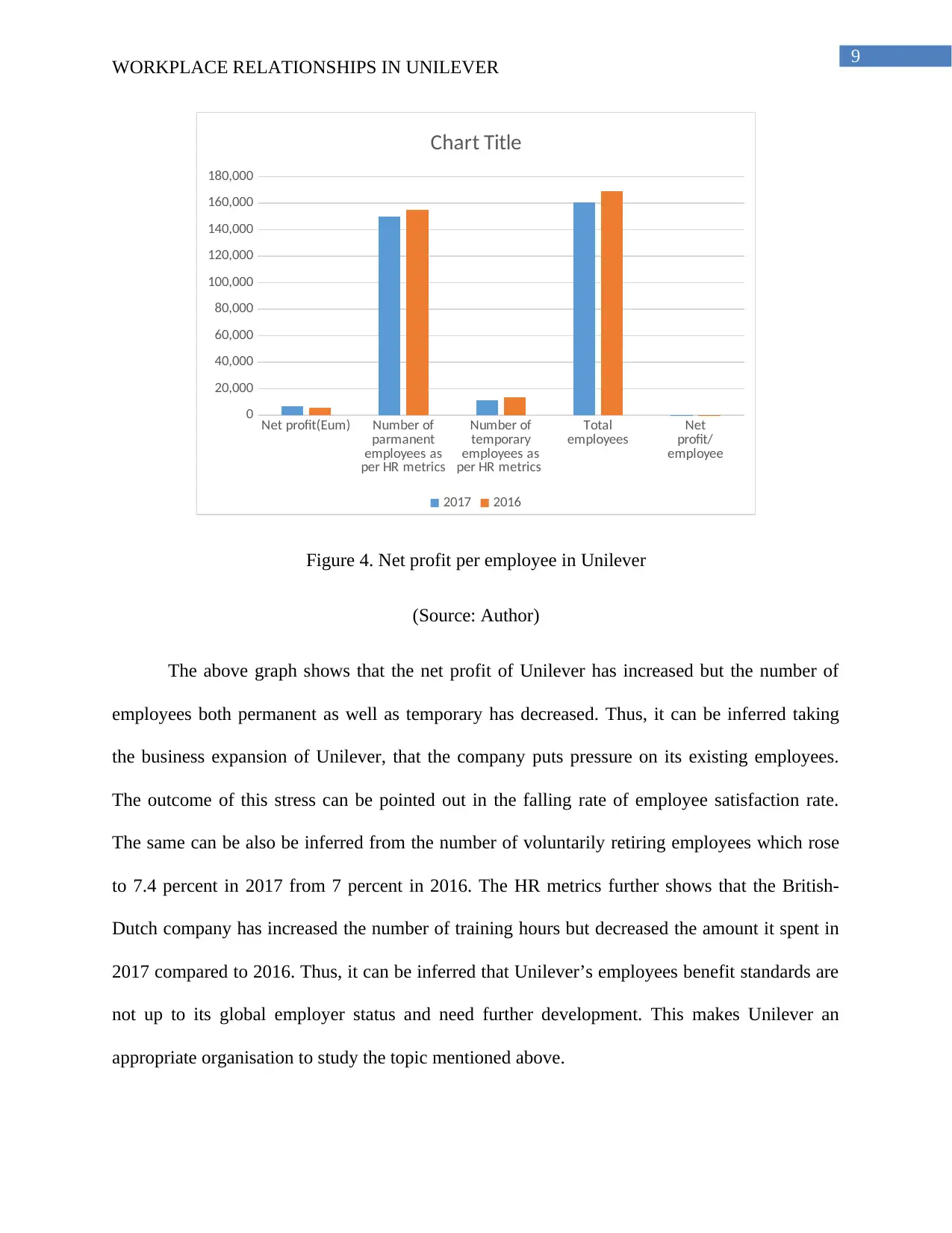
9
WORKPLACE RELATIONSHIPS IN UNILEVER
Net profit(Eum) Number of
parmanent
employees as
per HR metrics
Number of
temporary
employees as
per HR metrics
Total
employees Net
profit/
employee
0
20,000
40,000
60,000
80,000
100,000
120,000
140,000
160,000
180,000
Chart Title
2017 2016
Figure 4. Net profit per employee in Unilever
(Source: Author)
The above graph shows that the net profit of Unilever has increased but the number of
employees both permanent as well as temporary has decreased. Thus, it can be inferred taking
the business expansion of Unilever, that the company puts pressure on its existing employees.
The outcome of this stress can be pointed out in the falling rate of employee satisfaction rate.
The same can be also be inferred from the number of voluntarily retiring employees which rose
to 7.4 percent in 2017 from 7 percent in 2016. The HR metrics further shows that the British-
Dutch company has increased the number of training hours but decreased the amount it spent in
2017 compared to 2016. Thus, it can be inferred that Unilever’s employees benefit standards are
not up to its global employer status and need further development. This makes Unilever an
appropriate organisation to study the topic mentioned above.
WORKPLACE RELATIONSHIPS IN UNILEVER
Net profit(Eum) Number of
parmanent
employees as
per HR metrics
Number of
temporary
employees as
per HR metrics
Total
employees Net
profit/
employee
0
20,000
40,000
60,000
80,000
100,000
120,000
140,000
160,000
180,000
Chart Title
2017 2016
Figure 4. Net profit per employee in Unilever
(Source: Author)
The above graph shows that the net profit of Unilever has increased but the number of
employees both permanent as well as temporary has decreased. Thus, it can be inferred taking
the business expansion of Unilever, that the company puts pressure on its existing employees.
The outcome of this stress can be pointed out in the falling rate of employee satisfaction rate.
The same can be also be inferred from the number of voluntarily retiring employees which rose
to 7.4 percent in 2017 from 7 percent in 2016. The HR metrics further shows that the British-
Dutch company has increased the number of training hours but decreased the amount it spent in
2017 compared to 2016. Thus, it can be inferred that Unilever’s employees benefit standards are
not up to its global employer status and need further development. This makes Unilever an
appropriate organisation to study the topic mentioned above.
Paraphrase This Document
Need a fresh take? Get an instant paraphrase of this document with our AI Paraphraser
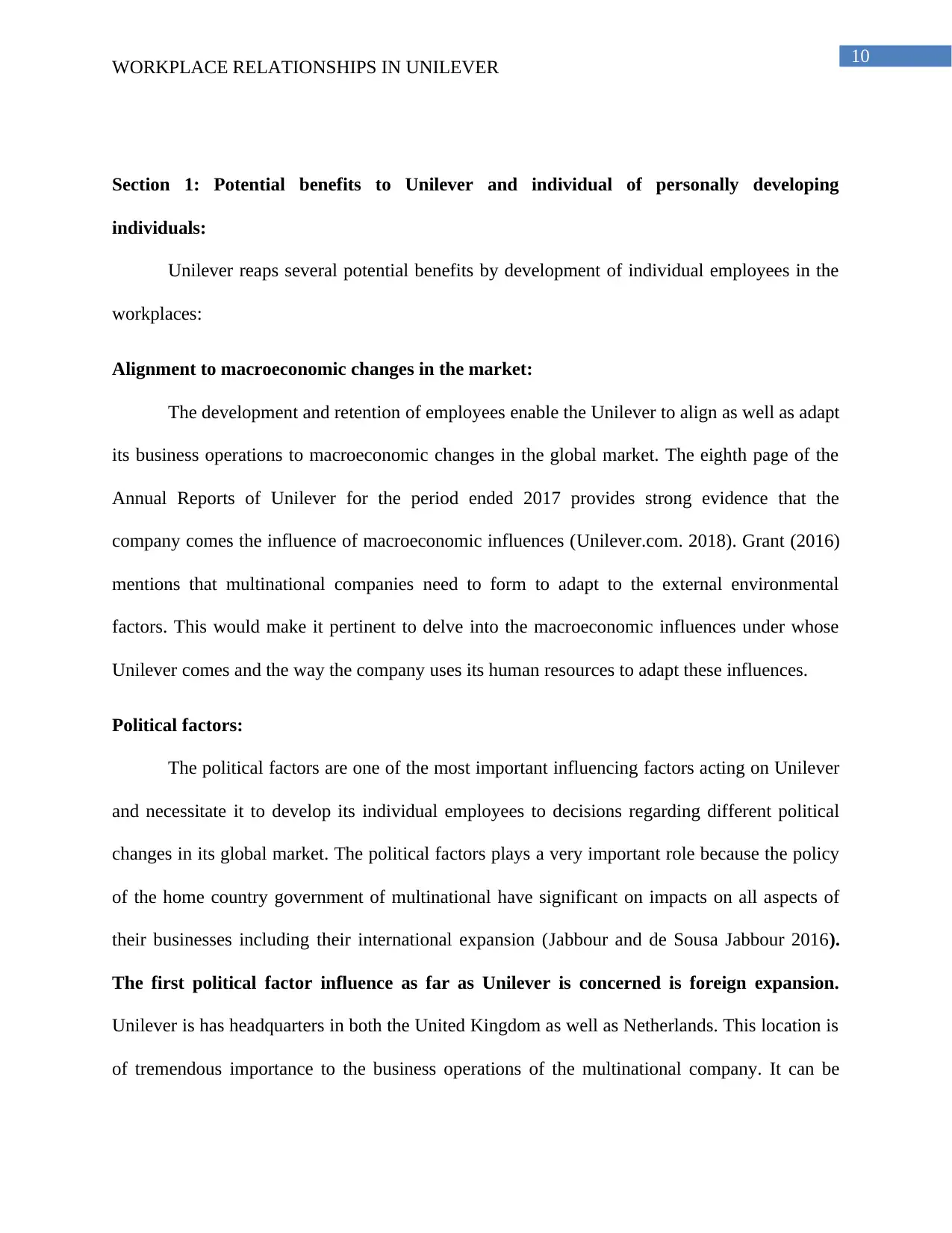
10
WORKPLACE RELATIONSHIPS IN UNILEVER
Section 1: Potential benefits to Unilever and individual of personally developing
individuals:
Unilever reaps several potential benefits by development of individual employees in the
workplaces:
Alignment to macroeconomic changes in the market:
The development and retention of employees enable the Unilever to align as well as adapt
its business operations to macroeconomic changes in the global market. The eighth page of the
Annual Reports of Unilever for the period ended 2017 provides strong evidence that the
company comes the influence of macroeconomic influences (Unilever.com. 2018). Grant (2016)
mentions that multinational companies need to form to adapt to the external environmental
factors. This would make it pertinent to delve into the macroeconomic influences under whose
Unilever comes and the way the company uses its human resources to adapt these influences.
Political factors:
The political factors are one of the most important influencing factors acting on Unilever
and necessitate it to develop its individual employees to decisions regarding different political
changes in its global market. The political factors plays a very important role because the policy
of the home country government of multinational have significant on impacts on all aspects of
their businesses including their international expansion (Jabbour and de Sousa Jabbour 2016).
The first political factor influence as far as Unilever is concerned is foreign expansion.
Unilever is has headquarters in both the United Kingdom as well as Netherlands. This location is
of tremendous importance to the business operations of the multinational company. It can be
WORKPLACE RELATIONSHIPS IN UNILEVER
Section 1: Potential benefits to Unilever and individual of personally developing
individuals:
Unilever reaps several potential benefits by development of individual employees in the
workplaces:
Alignment to macroeconomic changes in the market:
The development and retention of employees enable the Unilever to align as well as adapt
its business operations to macroeconomic changes in the global market. The eighth page of the
Annual Reports of Unilever for the period ended 2017 provides strong evidence that the
company comes the influence of macroeconomic influences (Unilever.com. 2018). Grant (2016)
mentions that multinational companies need to form to adapt to the external environmental
factors. This would make it pertinent to delve into the macroeconomic influences under whose
Unilever comes and the way the company uses its human resources to adapt these influences.
Political factors:
The political factors are one of the most important influencing factors acting on Unilever
and necessitate it to develop its individual employees to decisions regarding different political
changes in its global market. The political factors plays a very important role because the policy
of the home country government of multinational have significant on impacts on all aspects of
their businesses including their international expansion (Jabbour and de Sousa Jabbour 2016).
The first political factor influence as far as Unilever is concerned is foreign expansion.
Unilever is has headquarters in both the United Kingdom as well as Netherlands. This location is
of tremendous importance to the business operations of the multinational company. It can be
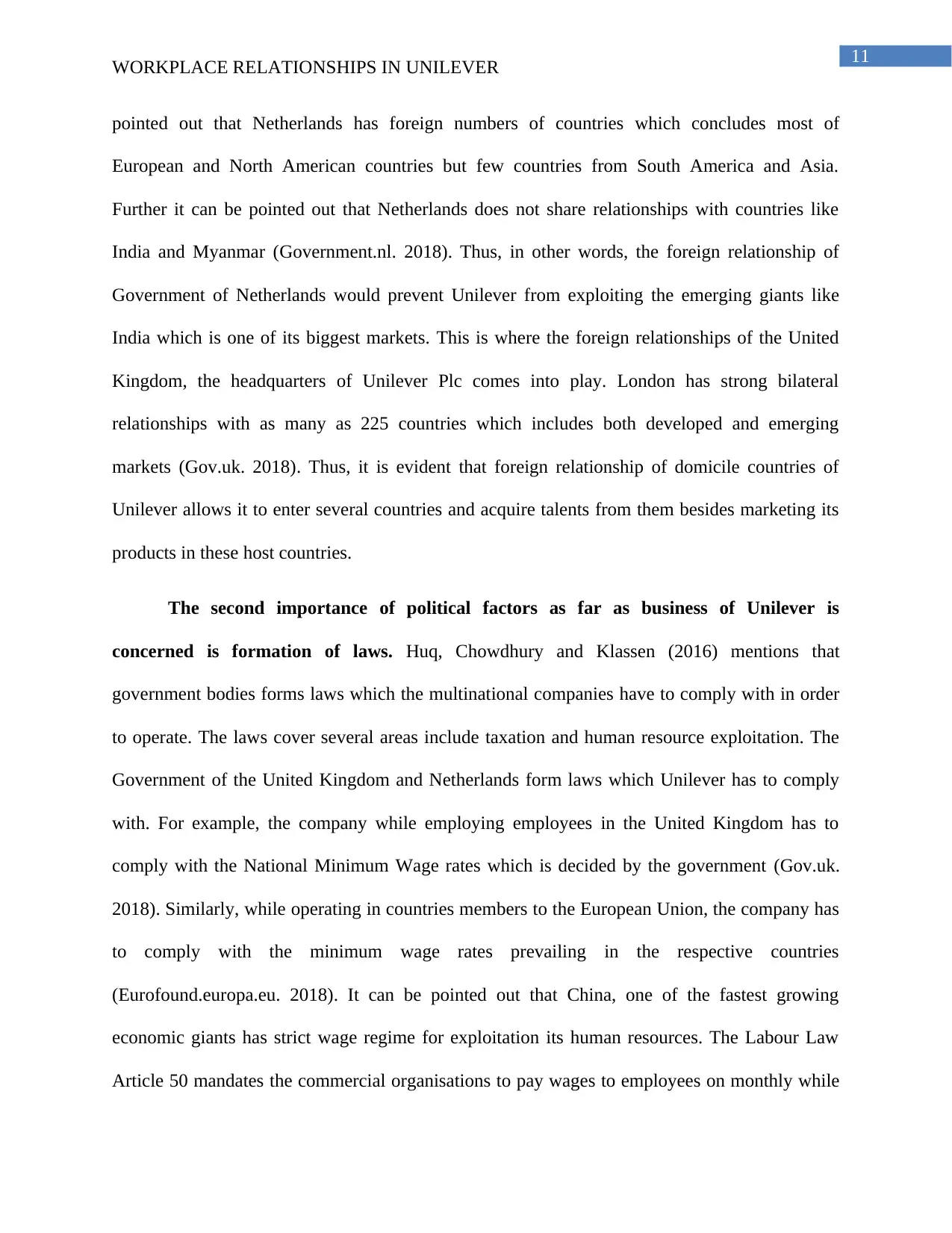
11
WORKPLACE RELATIONSHIPS IN UNILEVER
pointed out that Netherlands has foreign numbers of countries which concludes most of
European and North American countries but few countries from South America and Asia.
Further it can be pointed out that Netherlands does not share relationships with countries like
India and Myanmar (Government.nl. 2018). Thus, in other words, the foreign relationship of
Government of Netherlands would prevent Unilever from exploiting the emerging giants like
India which is one of its biggest markets. This is where the foreign relationships of the United
Kingdom, the headquarters of Unilever Plc comes into play. London has strong bilateral
relationships with as many as 225 countries which includes both developed and emerging
markets (Gov.uk. 2018). Thus, it is evident that foreign relationship of domicile countries of
Unilever allows it to enter several countries and acquire talents from them besides marketing its
products in these host countries.
The second importance of political factors as far as business of Unilever is
concerned is formation of laws. Huq, Chowdhury and Klassen (2016) mentions that
government bodies forms laws which the multinational companies have to comply with in order
to operate. The laws cover several areas include taxation and human resource exploitation. The
Government of the United Kingdom and Netherlands form laws which Unilever has to comply
with. For example, the company while employing employees in the United Kingdom has to
comply with the National Minimum Wage rates which is decided by the government (Gov.uk.
2018). Similarly, while operating in countries members to the European Union, the company has
to comply with the minimum wage rates prevailing in the respective countries
(Eurofound.europa.eu. 2018). It can be pointed out that China, one of the fastest growing
economic giants has strict wage regime for exploitation its human resources. The Labour Law
Article 50 mandates the commercial organisations to pay wages to employees on monthly while
WORKPLACE RELATIONSHIPS IN UNILEVER
pointed out that Netherlands has foreign numbers of countries which concludes most of
European and North American countries but few countries from South America and Asia.
Further it can be pointed out that Netherlands does not share relationships with countries like
India and Myanmar (Government.nl. 2018). Thus, in other words, the foreign relationship of
Government of Netherlands would prevent Unilever from exploiting the emerging giants like
India which is one of its biggest markets. This is where the foreign relationships of the United
Kingdom, the headquarters of Unilever Plc comes into play. London has strong bilateral
relationships with as many as 225 countries which includes both developed and emerging
markets (Gov.uk. 2018). Thus, it is evident that foreign relationship of domicile countries of
Unilever allows it to enter several countries and acquire talents from them besides marketing its
products in these host countries.
The second importance of political factors as far as business of Unilever is
concerned is formation of laws. Huq, Chowdhury and Klassen (2016) mentions that
government bodies forms laws which the multinational companies have to comply with in order
to operate. The laws cover several areas include taxation and human resource exploitation. The
Government of the United Kingdom and Netherlands form laws which Unilever has to comply
with. For example, the company while employing employees in the United Kingdom has to
comply with the National Minimum Wage rates which is decided by the government (Gov.uk.
2018). Similarly, while operating in countries members to the European Union, the company has
to comply with the minimum wage rates prevailing in the respective countries
(Eurofound.europa.eu. 2018). It can be pointed out that China, one of the fastest growing
economic giants has strict wage regime for exploitation its human resources. The Labour Law
Article 50 mandates the commercial organisations to pay wages to employees on monthly while
⊘ This is a preview!⊘
Do you want full access?
Subscribe today to unlock all pages.

Trusted by 1+ million students worldwide
1 out of 29
Related Documents
Your All-in-One AI-Powered Toolkit for Academic Success.
+13062052269
info@desklib.com
Available 24*7 on WhatsApp / Email
![[object Object]](/_next/static/media/star-bottom.7253800d.svg)
Unlock your academic potential
Copyright © 2020–2025 A2Z Services. All Rights Reserved. Developed and managed by ZUCOL.



